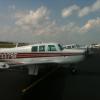-
Posts
29 -
Joined
-
Last visited
Contact Methods
-
Website URL
http://www.monticellofc.org
Profile Information
-
Gender
Male
-
Reg #
N3275F
-
Model
1967, M20F
Recent Profile Visitors
1,259 profile views
Monticello Flying Club's Achievements
-
Thanks everyone. Both Aerospace Welding in MN and Aero Engine Mount in NY quoted $650 to clean, inspect, install gussets and repaint. Since our overhaul is being done in NY we went with Aero Engine Mount since the shipping will be less. I will let you know how it turned out.
- 7 replies
-
- 3
-

-
- engine mount
- gusset
-
(and 1 more)
Tagged with:
-
Has anyone installed the engine mount gussets required by SB M20-192A to eliminate the recurrence of the AD? Does someone sell these gussets and about how much did it the whole work cost you? We are overhauling our engine and now would be the time to do it.
- 7 replies
-
- engine mount
- gusset
-
(and 1 more)
Tagged with:
-
TStepp, sorry about that. It's a 1967 M20F. I have small-kid-induced brain mush. Website corrected. Thanks for catching that.
- 10 replies
-
- 1
-

-
- oil temp
- cluster gauge
-
(and 4 more)
Tagged with:
-
Our not-for-profit Mooney flying club is upgrading our 1967 M20F to a CGR-30P total instrument. As such we are selling the below items to help off-set some of the upgrade cost. Each item comes with a photocopy of the logbook entry that provides all of the below information and states that the equipment was functional upon removal. FSDO says that's all you need to reinstall in a certified aircraft. Photos and prices (or best offer) are listed on our website at http://www.monticellofc.org/aircraft/For_Sale.html . We are waiting until the winter to add a new fuel level gauge which will allow us to sell all of the cluster gauges. Ammeter Shunt - Garwin P/N 22-370-60, Installed: Original to A/C Volt Meter - Mitchell P/N: 10-25105, Installed: 10/4/2010 Oil Temp Probe - Lewis Eng Co P/N AN5525, Serial Number: 25067, Installed: Original to A/C Oil Temp Connector - Amphenol P/N 97-3106A-125-35 - Installed new 3/8/14 Primary CHT Probe - Electronics International P-101 with A-101 adapter, Installed: 7/24/2015 Manifold Pressure/Fuel Pressure Gauge: 22-469-01A, Serial number: K76D67D, Installed: Original to A/C Engine Monitor - Electronics International Model US-8A-4, SN 17308 - Installed new 2/28/95 EI CHT Ring Probe - Electronics Internal P-102-18 - FAA/PMA approved - Installed 5/31/16 EI CHT Probe x3 - Electronics International P-100 - FAA/PMA approved - Installed various dates EI EGT Probes x4 - Electronics International P-110 - FAA/PMA approved - Installed various dates CHT Cluster Gauge - Garwin 169C-910-12 - Original to aircraft Oil Temp Cluster Gauge - Garwin 169C-910-11 - Original to aircraft Oil Pressure Cluster Gauge - Garwin 169C-914-1 - Original to aircraft Cluster Gauge Box w/connector - Garwin 22-169 - Original to aircraft L & R Fuel Gauges - Garwin 169C-910-28 1 and 2 - Original to aircraft, OH'd about 10 yrs ago Update 2/5/19 : I have lined out the items that are sold. The ones at the bottom are still available. For folks having oil temp probe problems, I highly recommend opening up the Amphenol connector on top of the probe, looking for loose wires, and re-soldering them. That happened to our old one, thus why the connector was newer than the probe. With all that engine vibration, that is the most likely culprit for no or intermittent oil temps. Another trick is to put wrist locks in the lines about an inch from the probe. That way you can open up the circuit, test continuity, and reconnect them.
- 10 replies
-
- oil temp
- cluster gauge
-
(and 4 more)
Tagged with:
-
From time to time, upon landing, our Garim 430 reboots. We have been able to recreate it at the ramp by reducing power to idle. Battery always has enough charge. The aircraft has a generator and fairly new voltage regulator. Our guess is that some how the voltage regulator is not picking up the drop off of the generator when the RPM's are reduced. Any other thoughts? Any way to test the regulator without replacing it and seeing if the issue goes away?
-

IO-360 idle problem
Monticello Flying Club replied to Monticello Flying Club's topic in Vintage Mooneys (pre-J models)
Thanks everyone. Turned out to be a loose bolt where the throttle arm connected to the throttle body that allowed for play. Nothing like paying $500 on a new throttle cable just to find a loose bolt. My mechanic claimed the cable needed to be replaced anyway, but I think they all say that in situations like this just to make you not feel so bad. -
We have a maintenance issue on our '67 M20F that has us stumped. If we bring the throttle back slowly she idles up at 1,000RPM. If we bring her back quickly, she goes all the way back to the normal approx. 600RPM. Mechanic thought it was a failure of the throttle cable sleeve pulling out of its set and installed a new cable. Unfortunately problem did not go away. We checked it with the cowl off and strangely the throttle body is at it's idle stop in both cases, whether its at 1,000RPM or 600RPM. Anyone got any thoughts?
-

engine air intake question
Monticello Flying Club replied to Monticello Flying Club's topic in Vintage Mooneys (pre-J models)
Orionflt - Thanks for the feedback. We loose about a qt every 10hrs from around the hold down bolts on cylinders 1 and 2. At 1 qt/10hrs and compressions in all in the upper 70's, I am not too worried about it. My guess is the gasket is leaking (last overhaul was in the 1990's). I think that oil is sliding down the outside of that intake air box and getting sucked in through that emergency air bypass door. I will try to test the compression on that bypass door screen spring at my next annual. I will also try to scrape that loose paint out soon. -Mike -
Only owned this 1967 M20F about a year and while cleaning my STC'd challenger air filter I wiped out intake box. Two things. I got a paper towel worth of oil out and my paper towel was covered in tiny paint chips, neither of which seems to be good things to have being sucked into the engine. I looked inside and sure enough, someone years ago painted the inside of the intake air box and now the paint is chipping. The oil is pooling in the bottom and I am assuming is being sucked in around the engine side emergency bypass door. So first, is the inside of everyone else's intake air box painted (seems like a really bad idea to paint it for the very reason of paint chips), second does anyone else have oil inside their intake box, and third, are either of these major things to be worried about? I am not looking forward to having to strip all of the paint out from the inside of that box. Thanks.
-

NAV light switch
Monticello Flying Club replied to MtPleasantFlyer's topic in Vintage Mooneys (pre-J models)
I had this same problem. Notar is correct, the Tyco are not PMA'd, use at your own risk. I would hate to be blamed by the insurance company for a fire in the cockpit (or anything else they decide to link to the switch) over $120. I also replaced my landing light with an LED hoping like N201MKTurbo said it would make a difference. Made no difference. If the switch feels a lot looser than the other switches, it is a bad switch. You should be able to feel a difference in the switch. -

Old OAT Probe
Monticello Flying Club replied to Bob_Belville's topic in Vintage Mooneys (pre-J models)
The only other reason to leave it in is its great role as an ice detection device. I always pick up ice there first. Anyone considering removing it, just make sure that your other monitoring device is certified as a primary instrument. Many aircraft monitors are not certified as a primary instrument. -
Thanks everyone. We ended up doing it at the annual and will probably wait to do it again until the next annual. We did pull both scat tubes first, made sure there was an oil pan underneath, then removed the nut from the screen (there is not enough clearance for both the nut and screen to be completely removed together). If the screen does not come out with the nut, find someone with skinny hands to stick a pinky into the hole and drag the screen out. One thing to note is that at least on ours, one end is flared. That is the end that has to go back in first. I then used my pinky finger to wipe the insides of the hole to make sure nothing was left behind. Good news was that no particles were found. After cleaning with brake cleaner, I put the screen back in first, leaving it out about a half inch, put a new crush washer around the nut (split side toward the case), then pushed the nut back on top of the screen while holding the screen (the screen end actually fits inside the nut for those not having done this before), then finger tightened the nut. The manual has a degrees of turn per threading, but my A&P just tightened it until it felt right and then proceeded to curse while doing the safety wiring.
-

Century vs Bendix HSI
Monticello Flying Club replied to Monticello Flying Club's topic in General Mooney Talk
Thanks everyone. Turned out to be an electrical wiring issue, not an instrument issue. If you get indication errors (not gyro errors) in your mechanical HSI, I highly recommend working with an A&P to test the continuity in the wiring between the Nav radio and the HSI before going through the trouble of removing and shipping off the HSI. Pinning diagrams available on the web can tell you which pin controls which indication. Different pins control the left/right deviation, up/down deviation, and signal failure flags. Turned out on ours that a mid-wiring connection became loose so the signal was lost, making the flag go up. Had we shipped it off they would not have gotten the error but still would have charged us diagnostic time. -

New induction couplings for Es and Fs
Monticello Flying Club replied to DaV8or's topic in Vintage Mooneys (pre-J models)
Thanks everyone for the install tips. We were able to do it without removing the lower cowl. The biggest pain was the safety wires (which by the way hadn't been saftied the last time it was replaced). Attached is a picture of our removed one. Our concern was that pieces of this hole were getting sucked into our engine. I good thing to look for if you are buying a Mooney since apparently you couldn't buy these for a few years so there are a number of A/C out there with patched instead of replaced ducts. Around $450 total installed.





